Ecosystem Service Value Dynamics in the Yellow River Delta National Nature Reserve, China: Conservation Implications from Two Decades of Change
Abstract
1. Introduction
2. Materials and Methods
2.1. Study Area
2.2. Data Sources
2.3. Research Methods
2.3.1. Data Processing Flow
2.3.2. ESV Calculation Methods
2.3.3. Sensitivity Coefficient
2.3.4. Trend of ESV Change
2.3.5. Geo-Detector
2.3.6. Hurst Exponent
3. Results
3.1. Analysis of the Spatial Distribution Characteristics of ESV
3.2. Analysis of the Variation Trend of ESV
3.2.1. Temporal Variation Trend of ESV
3.2.2. Spatial Variation Trends of ESV
3.3. Driving Factor Analysis
3.4. The Future Trend Prediction of ESV
4. Discussion
4.1. The Spatial Distribution Characteristics of ESV
4.2. The Variation Trend of ESV
4.3. Trade-Offs, Synergies, and Integrated Management Implications
4.4. Study Limitations
5. Conclusions
Supplementary Materials
Author Contributions
Funding
Data Availability Statement
Acknowledgments
Conflicts of Interest
References
- Brander, L.M.; de Groot, R.; Schägner, J.P.; Guisado-Goñi, V.; van ‘t Hoff, V.; Solomonides, S.; McVittie, A.; Eppink, F.; Sposato, M.; Do, L.; et al. Economic values for ecosystem services: A global synthesis and way forward. Ecosyst. Serv. 2024, 66, 101606. [Google Scholar] [CrossRef]
- Costanza, R.; de Groot, R.; Sutton, P.; van der Ploeg, S.; Anderson, S.J.; Kubiszewski, I.; Farber, S.; Turner, R.K. Changes in the global value of ecosystem services. Glob. Environ. Chang. 2014, 26, 152–158. [Google Scholar] [CrossRef]
- Moreira, M.; Alves, J.; Frazão, L.; Gouveia, A.C.; Freitas, H. A systematic review of Nature’s Contributions to People: Impacts on science, policy, and sustainability. Sustain. Sci. 2025. [Google Scholar] [CrossRef]
- Czúcz, B.; Haines-Young, R.; Kiss, M.; Bereczki, K.; Kertész, M.; Vári, Á.; Potschin-Young, M.; Arany, I. Ecosystem service indicators along the cascade: How do assessment and mapping studies position their indicators? Ecol. Indic. 2020, 118, 106729. [Google Scholar] [CrossRef]
- Zhang, X.; Li, S.; Yu, H. Analysis on the ecosystem service protection effect of national nature reserve in Qinghai-Tibetan Plateau from weight perspective. Ecol. Indic. 2022, 142, 109225. [Google Scholar] [CrossRef]
- Liu, P.; Jiang, S.; Zhao, L.; Li, Y.; Zhang, P.; Zhang, L. What are the benefits of strictly protected nature reserves? Rapid assessment of ecosystem service values in Wanglang Nature Reserve, China. Ecosyst. Serv. 2017, 26, 70–78. [Google Scholar] [CrossRef]
- Xie, G.; Zhang, C.; Zhen, L.; Zhang, L. Dynamic changes in the value of China’s ecosystem services. Ecosyst. Serv. 2017, 26, 146–154. [Google Scholar] [CrossRef]
- Hasan, S.S.; Zhen, L.; Miah, M.G.; Ahamed, T.; Samie, A. Impact of land use change on ecosystem services: A review. Environ. Dev. 2020, 34, 100527. [Google Scholar] [CrossRef]
- Tolessa, T.; Senbeta, F.; Kidane, M. The impact of land use/land cover change on ecosystem services in the central highlands of Ethiopia. Ecosyst. Serv. 2017, 23, 47–54. [Google Scholar] [CrossRef]
- Turner, K.G.; Anderson, S.; Gonzales-Chang, M.; Costanza, R.; Courville, S.; Dalgaard, T.; Dominati, E.; Kubiszewski, I.; Ogilvy, S.; Porfirio, L.; et al. A review of methods, data, and models to assess changes in the value of ecosystem services from land degradation and restoration. Ecol. Model. 2016, 319, 190–207. [Google Scholar] [CrossRef]
- Gong, J.; Xie, Y.; Cao, E.; Huang, Q.; Li, H. Integration of InVEST-habitat quality model with landscape pattern indexes to assess mountain plant biodiversity change: A case study of Bailongjiang watershed in Gansu Province. J. Geogr. Sci. 2019, 29, 1193–1210. [Google Scholar] [CrossRef]
- Russo, D.; Bosso, L.; Ancillotto, L. Novel perspectives on bat insectivory highlight the value of this ecosystem service in farmland: Research frontiers and management implications. Agric. Ecosyst. Environ. 2018, 266, 31–38. [Google Scholar] [CrossRef]
- Feng, X.; Li, Y.; Wang, X.; Yang, J.; Yu, E.; Wang, S.; Wu, N.; Xiao, F. Impacts of land use transitions on ecosystem services: A research framework coupled with structure, function, and dynamics. Sci. Total Environ. 2023, 901, 166366. [Google Scholar] [CrossRef] [PubMed]
- Xue, S.; Yao, L.; Xu, Y.; Li, C. Spatiotemporal Dynamics and Driving Factors of Ecosystem Services in the Yellow River Delta, China. Sustainability 2024, 16, 3466. [Google Scholar] [CrossRef]
- Temmerman, S.; Horstman, E.M.; Krauss, K.W.; Mullarney, J.C.; Pelckmans, I.; Schoutens, K. Marshes and Mangroves as Nature-Based Coastal Storm Buffers. Annu. Rev. Mar. Sci. 2023, 15, 95–118. [Google Scholar] [CrossRef]
- Somay-Altas, M.; Sanli, E. Urban Wetlands as EcoHaven Oasis: Hydrogeochemical Insights from the Inciralti-Cakalburnu Urban Wetland (ICUW) in Izmir, Turkiye. Water Air Soil Pollut. 2025, 236, 208. [Google Scholar] [CrossRef]
- Hansen, V.D.; Nestlerode, J.A. Carbon sequestration in wetland soils of the northern Gulf of Mexico coastal region. Wetl. Ecol. Manag. 2014, 22, 289–303. [Google Scholar] [CrossRef]
- Rodríguez-Santalla, I.; Navarro, N. Main Threats in Mediterranean Coastal Wetlands. The Ebro Delta Case. J. Mar. Sci. Eng. 2021, 9, 1190. [Google Scholar] [CrossRef]
- Wang, X.; Lian, Y.; Huang, C.; Wang, X.; Wang, R.; Shan, K.; Pedroli, B.; van Eupen, M.; ElMahdi, A.; Ali, M. Environmental flows and its evaluation of restoration effect based on LEDESS model in Yellow River Delta wetlands. Mitig. Adapt. Strateg. Glob. Chang. 2011, 17, 357–367. [Google Scholar] [CrossRef]
- Huang, Z.; Lu, Y.; Meng, W.; Mo, X.; Xu, W.; Yun, H.; He, M.; Wang, Y. Study on suitability assessment of waterbird habitats along the Bohai Rim. Ecol. Indic. 2023, 150, 110229. [Google Scholar] [CrossRef]
- Zhang, B.; Zhang, Q.; Feng, Q.; Cui, B.; Zhang, S. Simulation of the spatial stresses due to territorial land development on Yellow River Delta Nature Reserve using a GIS-based assessment model. Environ. Monit. Assess. 2017, 189, 331. [Google Scholar] [CrossRef]
- Cai, Z.; Zhang, Z.; Zhao, F.; Guo, X.; Zhao, J.; Xu, Y.; Liu, X. Assessment of eco-environmental quality changes and spatial heterogeneity in the Yellow River Delta based on the remote sensing ecological index and geo-detector model. Ecol. Inform. 2023, 77, 102203. [Google Scholar] [CrossRef]
- Dou, X.; Guo, H.; Zhang, L.; Liang, D.; Zhu, Q.; Liu, X.; Zhou, H.; Lv, Z.; Liu, Y.; Gou, Y.; et al. Dynamic landscapes and the influence of human activities in the Yellow River Delta wetland region. Sci. Total Environ. 2023, 899, 166239. [Google Scholar] [CrossRef]
- Shi, H.; Lu, J.; Zheng, W.; Sun, J.; Li, J.; Guo, Z.; Huang, J.; Yu, S.; Yin, L.; Wang, Y.; et al. Evaluation system of coastal wetland ecological vulnerability under the synergetic influence of land and sea: A case study in the Yellow River Delta, China. Mar. Pollut. Bull. 2020, 161, 111735. [Google Scholar] [CrossRef] [PubMed]
- Chi, Y.; Shi, H.; Zheng, W.; Sun, J.; Fu, Z. Spatiotemporal characteristics and ecological effects of the human interference index of the Yellow River Delta in the last 30 years. Ecol. Indic. 2018, 89, 880–892. [Google Scholar] [CrossRef]
- Costanza, R.; de Groot, R.; Braat, L.; Kubiszewski, I.; Fioramonti, L.; Sutton, P.; Farber, S.; Grasso, M. Twenty years of ecosystem services: How far have we come and how far do we still need to go? Ecosyst. Serv. 2017, 28, 1–16. [Google Scholar] [CrossRef]
- Li, C.; Wu, Y.; Gao, B.; Zheng, K.; Wu, Y.; Li, C. Multi-scenario simulation of ecosystem service value for optimization of land use in the Sichuan-Yunnan ecological barrier, China. Ecol. Indic. 2021, 132, 108328. [Google Scholar] [CrossRef]
- Song, W.; Deng, X. Land-use/land-cover change and ecosystem service provision in China. Sci. Total Environ. 2017, 576, 705–719. [Google Scholar] [CrossRef]
- Kibria, A.S.M.G.; Costanza, R.; Gasparatos, A.; Soto, J. A composite human wellbeing index for ecosystem-dependent communities: A case study in the Sundarbans, Bangladesh. Ecosyst. Serv. 2022, 53, 101389. [Google Scholar] [CrossRef]
- Liu, J.; Chen, X.; Chen, W.; Zhang, Y.; Wang, A.; Zheng, Y. Ecosystem Service Value Evaluation of Saline—Alkali Land Development in the Yellow River Delta—The Example of the Huanghe Island. Water 2023, 15, 477. [Google Scholar] [CrossRef]
- Yan, J.; Zhu, J.; Zhao, S.; Su, F. Coastal wetland degradation and ecosystem service value change in the Yellow River Delta, China. Glob. Ecol. Conserv. 2023, 44, e02501. [Google Scholar] [CrossRef]
- Zhang, X.; He, S.; Yang, Y. Evaluation of wetland ecosystem services value of the yellow river delta. Environ. Monit. Assess. 2021, 193, 353. [Google Scholar] [CrossRef]
- Qi, B.; Yu, M.; Li, Y. Multi-Scenario Prediction of Land-Use Changes and Ecosystem Service Values in the Lhasa River Basin Based on the FLUS-Markov Model. Land 2024, 13, 597. [Google Scholar] [CrossRef]
- Kong, D.; Miao, C.; Borthwick, A.G.L.; Duan, Q.; Liu, H.; Sun, Q.; Ye, A.; Di, Z.; Gong, W. Evolution of the Yellow River Delta and its relationship with runoff and sediment load from 1983 to 2011. J. Hydrol. 2015, 520, 157–167. [Google Scholar] [CrossRef]
- Zhao, Y.; Luo, L.; Zhang, L.; Sun, J.; Lu, Z. Spatiotemporal evolution and driving forces of ecosystem service values in the Yellow River Delta. Ecol. Indic. 2025, 173, 13432. [Google Scholar] [CrossRef]
- Zhou, D.; Zhang, H.; Zhang, X.; Zhang, W.; Zhang, T.; Lu, C. Habitat changes in the most important stopover sites for the endangered red-crowned crane in China: A large-scale study. Environ. Sci. Pollut. Res. 2021, 28, 54719–54727. [Google Scholar] [CrossRef] [PubMed]
- Cui, Y.; Xiao, R.; Zhang, M.; Wang, C.; Ma, Z.; Xiu, Y.; Wang, Q.; Guo, Y. Hydrological connectivity dynamics and conservation priorities for surface-water patches in the Yellow River Delta National Nature Reserve, China. Ecohydrol. Hydrobiol. 2020, 20, 525–536. [Google Scholar] [CrossRef]
- Yin, Y.; Yang, R.; Song, Z.; Lu, Y.; Zhang, Y.; Zhang, L.; Sun, M.; Li, X. Simulation of wetland carbon storage in coastal cities under the coupled framework of socio-economic and ecological sustainability: A case study of Dongying city. Sustain. Cities Soc. 2024, 108, 105481. [Google Scholar] [CrossRef]
- Sun, B.; Wang, H.; Wu, X.; Bi, N.; Wang, G.; Wang, M.; Wang, B. Dual impacts of human activities on land cover and carbon storage in the Yellow River Delta (1986–2023). Ocean. Coast. Manag. 2025, 267, 107655. [Google Scholar] [CrossRef]
- Barbier, E.B.; Hacker, S.D.; Kennedy, C.; Koch, E.W.; Stier, A.C.; Silliman, B.R. The value of estuarine and coastal ecosystem services. Ecol. Monogr. 2011, 81, 169–193. [Google Scholar] [CrossRef]
- Gong, Y.; Cai, M.; Yao, L.; Cheng, L.; Hao, C.; Zhao, Z. Assessing Changes in the Ecosystem Services Value in Response to Land-Use/Land-Cover Dynamics in Shanghai from 2000 to 2020. Int. J. Environ. Res. Public Health 2022, 19, 12080. [Google Scholar] [CrossRef]
- Kindu, M.; Schneider, T.; Teketay, D.; Knoke, T. Changes of ecosystem service values in response to land use/land cover dynamics in Munessa–Shashemene landscape of the Ethiopian highlands. Sci. Total Environ. 2016, 547, 137–147. [Google Scholar] [CrossRef]
- Zheng, Y.; Sang, X.; Li, Z.; Zhang, S.; Chang, J. Ecological services value of ‘natural-artificial’ water cycle: Valuation method and its application in the Yangtze River Basin of China. Ecol. Indic. 2024, 158, 111324. [Google Scholar] [CrossRef]
- Liu, M.; Fan, J.; Wang, Y.; Hu, C. Study on Ecosystem Service Value (ESV) Spatial Transfer in the Central Plains Urban Agglomeration in the Yellow River Basin, China. Int. J. Environ. Res. Public Health 2021, 18, 9751. [Google Scholar] [CrossRef] [PubMed]
- Zhang, Z.; Han, L.; Feng, Z.; Zhou, J.; Wang, S.; Wang, X.; Fan, J. Estimating the Past and Future Trajectory of LUCC on Wetland Ecosystem Service Values in the Yellow River Delta Region of China. Sustainability 2024, 16, 619. [Google Scholar] [CrossRef]
- Yuan, D.; Du, M.; Yan, C.; Wang, J.; Wang, C.; Zhu, Y.; Wang, H.; Kou, Y. Coupling coordination degree analysis and spatiotemporal heterogeneity between water ecosystem service value and water system in Yellow River Basin cities. Ecol. Inform. 2024, 79, 102440. [Google Scholar] [CrossRef]
- Li, R.; Xu, Q.; Yu, J.; Chen, L.; Peng, Y. Multiscale assessment of the spatiotemporal coupling relationship between urbanization and ecosystem service value along an urban–rural gradient:A case study of the Yangtze River Delta urban agglomeration, China. Ecol. Indic. 2024, 160, 111864. [Google Scholar] [CrossRef]
- Xiao, J.; Zhang, Y.; Xu, H. Response of ecosystem service values to land use change, 2002–2021. Ecol. Indic. 2024, 160, 111947. [Google Scholar] [CrossRef]
- Bhuyan, M.; Singh, B.; Vid, S.; Jeganathan, C. Analysing the spatio-temporal patterns of vegetation dynamics and their responses to climatic parameters in Meghalaya from 2001 to 2020. Environ. Monit. Assess. 2023, 195, 94. [Google Scholar] [CrossRef]
- Zhang, X.; Zheng, Z.; Sun, S.; Wen, Y.; Chen, H. Study on the driving factors of ecosystem service value under the dual influence of natural environment and human activities. J. Clean. Prod. 2023, 420, 138408. [Google Scholar] [CrossRef]
- Chen, T.; Feng, Z.; Zhao, H.; Wu, K. Identification of ecosystem service bundles and driving factors in Beijing and its surrounding areas. Sci. Total Environ. 2020, 711, 134687. [Google Scholar] [CrossRef]
- Peng, J.; Liu, Z.; Liu, Y.; Wu, J.; Han, Y. Trend analysis of vegetation dynamics in Qinghai–Tibet Plateau using Hurst Exponent. Ecol. Indic. 2012, 14, 28–39. [Google Scholar] [CrossRef]
- Wang, W.; Xu, J.; Luan, X.; Zhang, Z. Wetland ecosystem service values in Beijing significantly increased from 1984 to 2020: Trend changes, type evolution, and driving factor. Ecol. Indic. 2024, 166, 112235. [Google Scholar] [CrossRef]
- Wen, X.; Wang, J.; Han, X. Impact of land use evolution on the value of ecosystem services in the returned farmland area of the Loess Plateau in northern Shaanxi. Ecol. Indic. 2024, 163, 112119. [Google Scholar] [CrossRef]
- Li, Y.; Shangguan, S.; Li, W.; Liu, S.; Li, Y.; Han, R.; Xu, J. Spatial–temporal distribution of farmland occupation and compensation and its impact on ecological service value in China from 1990 to 2021. Sci. Rep. 2025, 15, 14010. [Google Scholar] [CrossRef] [PubMed]
- Zhang, B.; Feng, Q.; Lu, Z.; Li, Z.; Zhang, B.; Cheng, W. Ecosystem service value and ecological compensation in Qilian Mountain National Park: Implications for ecological conservation strategies. Ecol. Indic. 2024, 167, 112661. [Google Scholar] [CrossRef]
- Chan, K.K.Y.; Ren, Z.; Liu, Y.; Song, H.; Bai, Y.; Xu, B. Land Cover Change and Fragmentation Within China’s Ramsar Sites. Remote Sens. 2025, 17, 896. [Google Scholar] [CrossRef]
- Guo, X.; Zhang, Y.; Guo, D.; Lu, W.; Xu, H. How does ecological protection redline policy affect regional land use and ecosystem services? Environ. Impact Assess. Rev. 2023, 100, 107062. [Google Scholar] [CrossRef]
- Bornman, T.G.; Schmidt, J.; Adams, J.B.; Mfikili, A.N.; Farre, R.E.; Smit, A.J. Relative sea-level rise and the potential for subsidence of the Swartkops Estuary intertidal salt marshes, South Africa. S. Afr. J. Bot. 2016, 107, 91–100. [Google Scholar] [CrossRef]
- Wang, J.; Ding, J.; Wang, Y.; Ge, X.; Lizaga, I.; Chen, X. Soil salinization in drylands: Measure, monitor, and manage. Ecol. Indic. 2025, 175, 113608. [Google Scholar] [CrossRef]
- Cao, C.; Su, F.; Song, F.; Yan, H.; Pang, Q. Distribution and disturbance dynamics of habitats suitable for Suaeda salsa. Ecol. Indic. 2022, 140, 108984. [Google Scholar] [CrossRef]
- Shi, Z.; Pu, W.; Dong, J. Spatiotemporal Changes of Land Use and Their Impacts on Ecosystem Service Value in the Agro-pastoral Ecotone of Northern China. Environ. Sci. 2025, 46, 2373–2384. [Google Scholar] [CrossRef]
- Bryan, B.A.; Gao, L.; Ye, Y.; Sun, X.; Connor, J.D.; Crossman, N.D.; Stafford-Smith, M.; Wu, J.; He, C.; Yu, D. China’s response to a national land-system sustainability emergency. Nature 2018, 559, 193–204. [Google Scholar] [CrossRef] [PubMed]
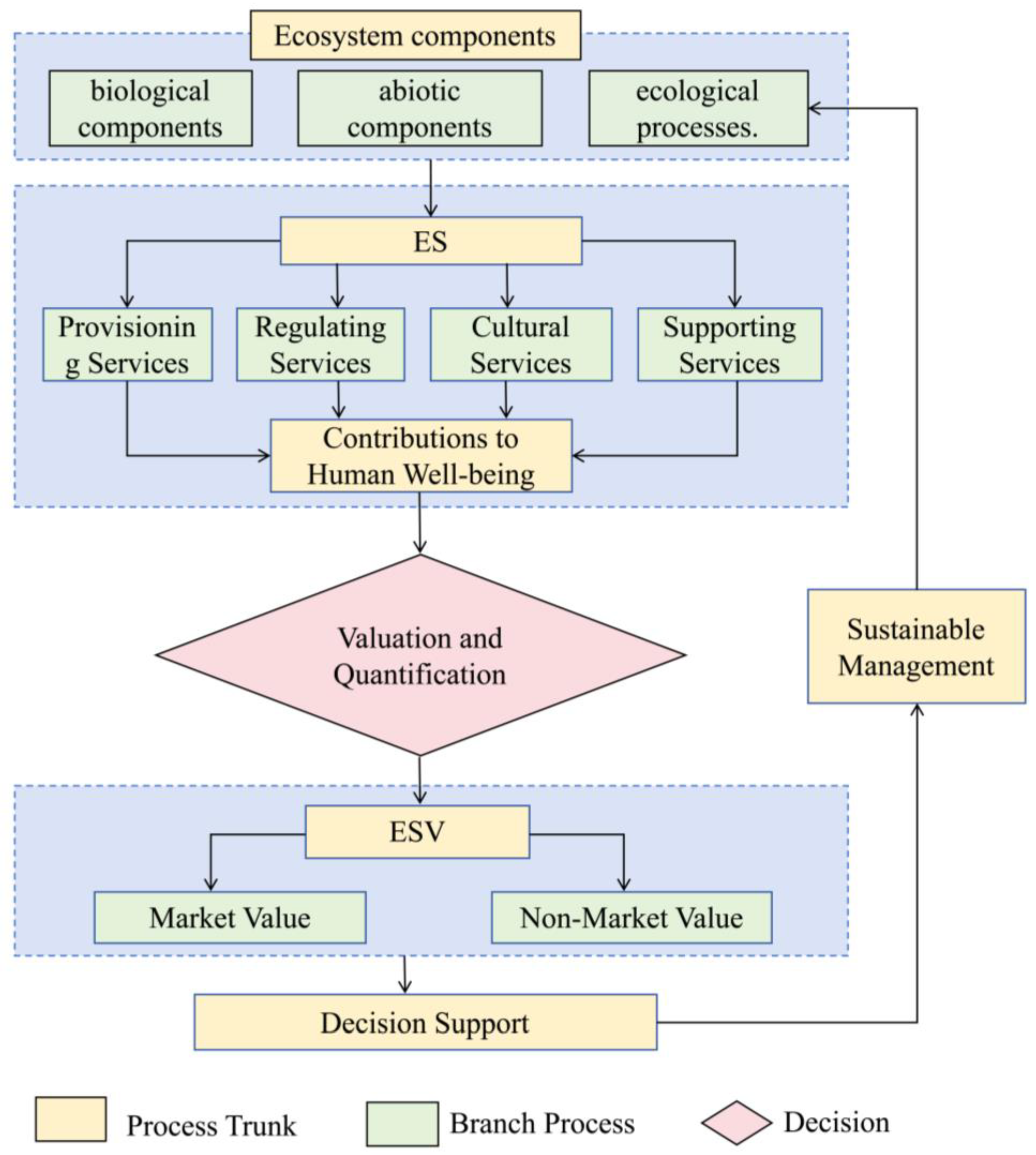
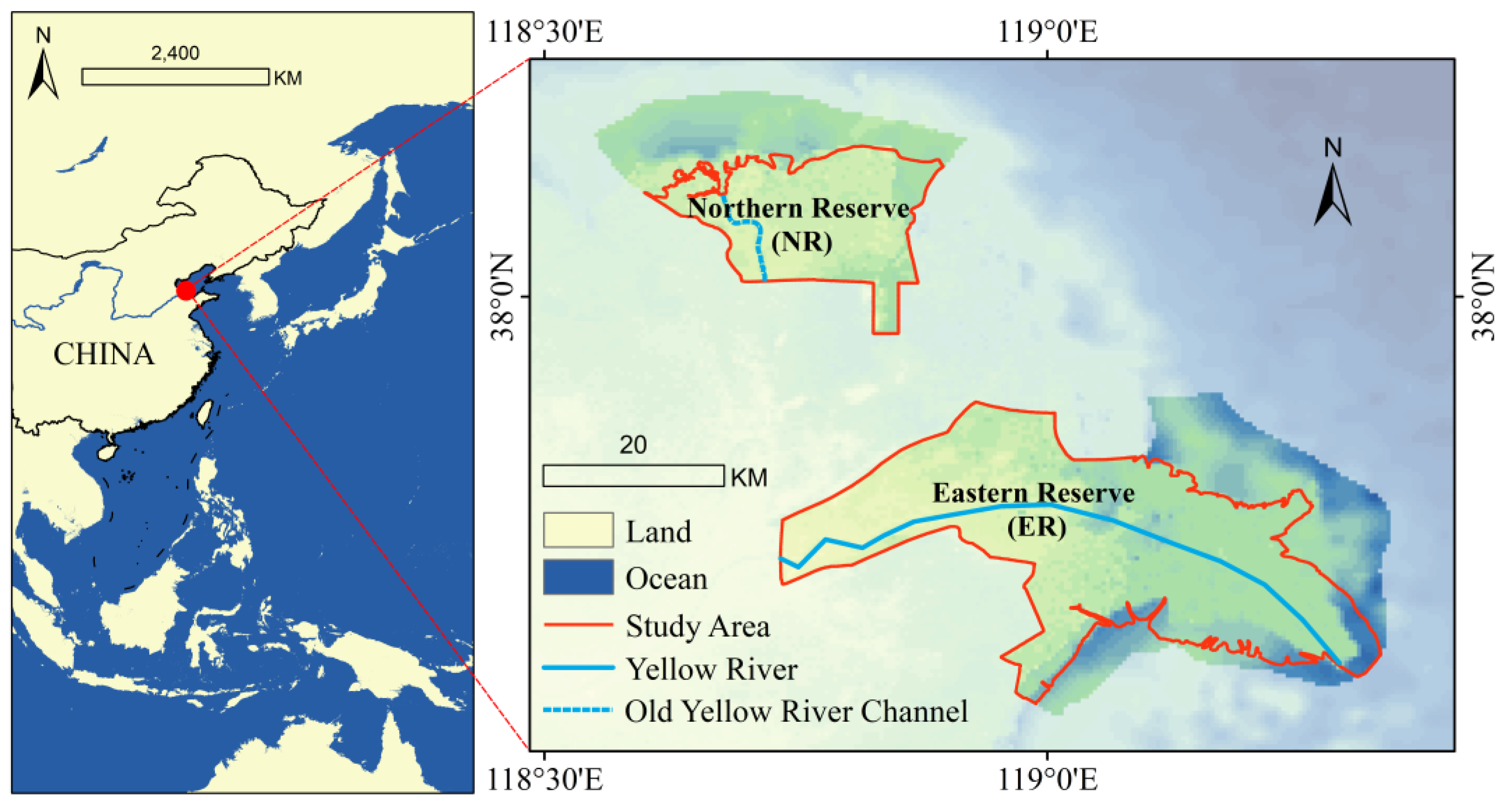
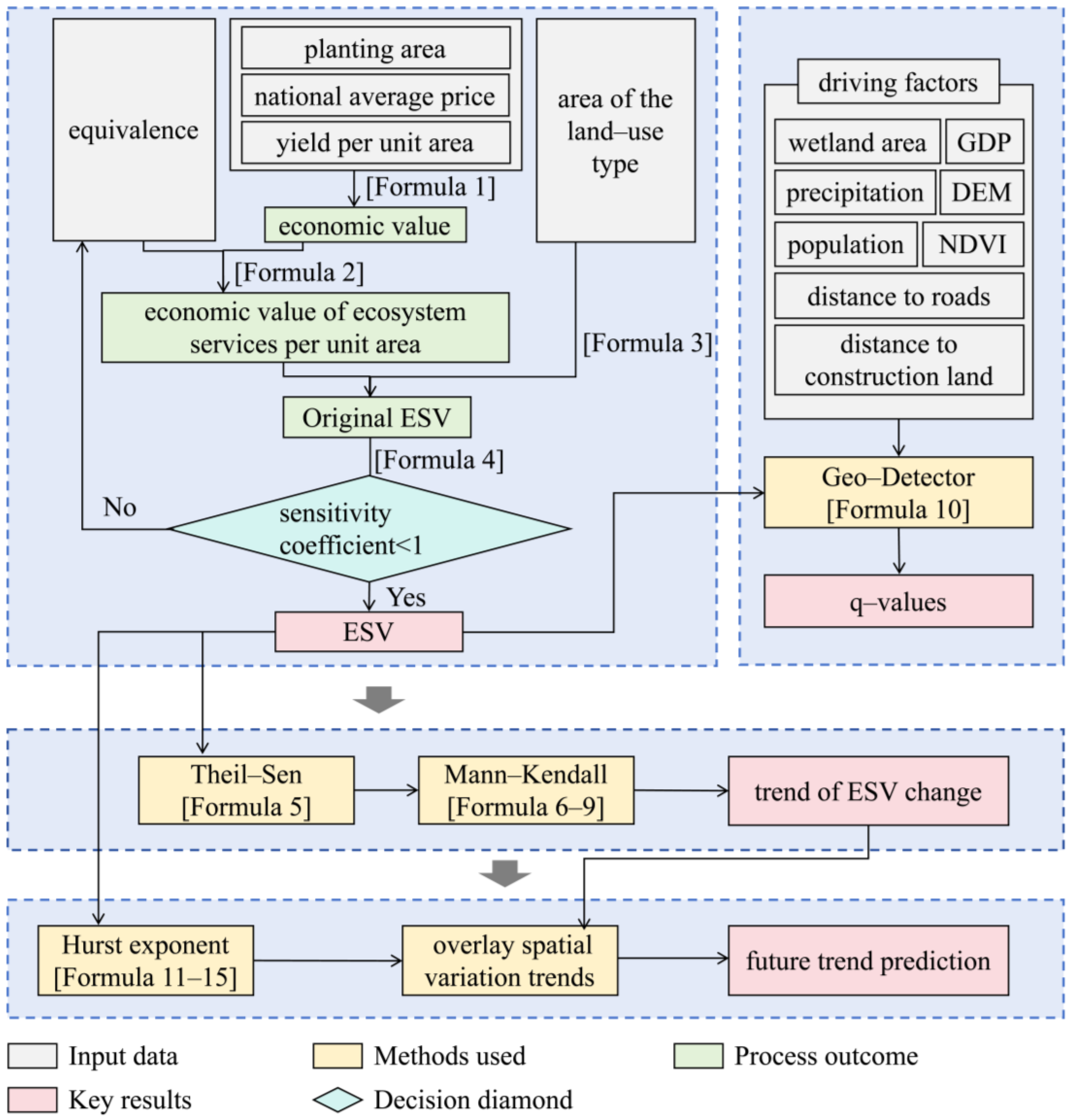
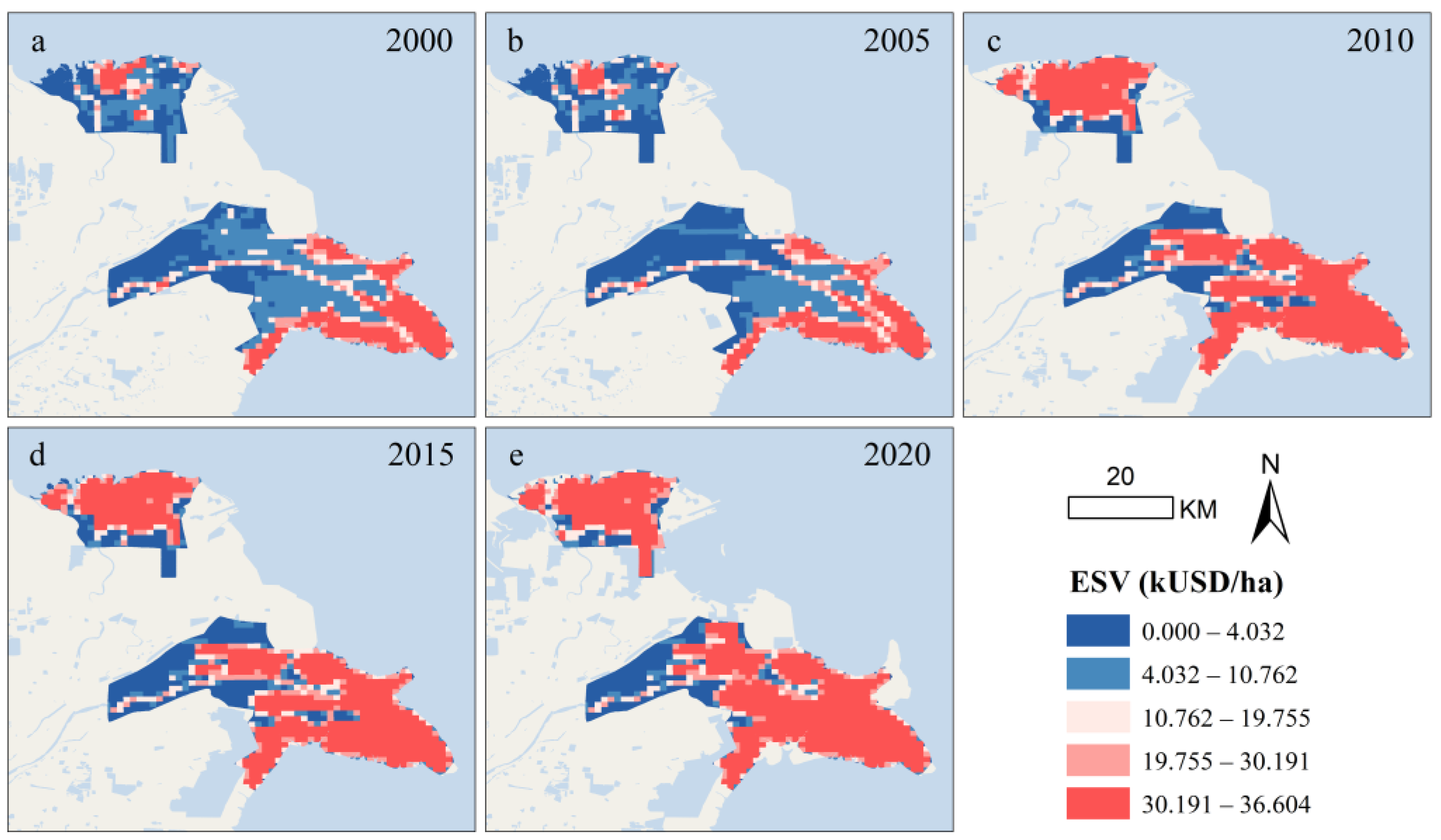
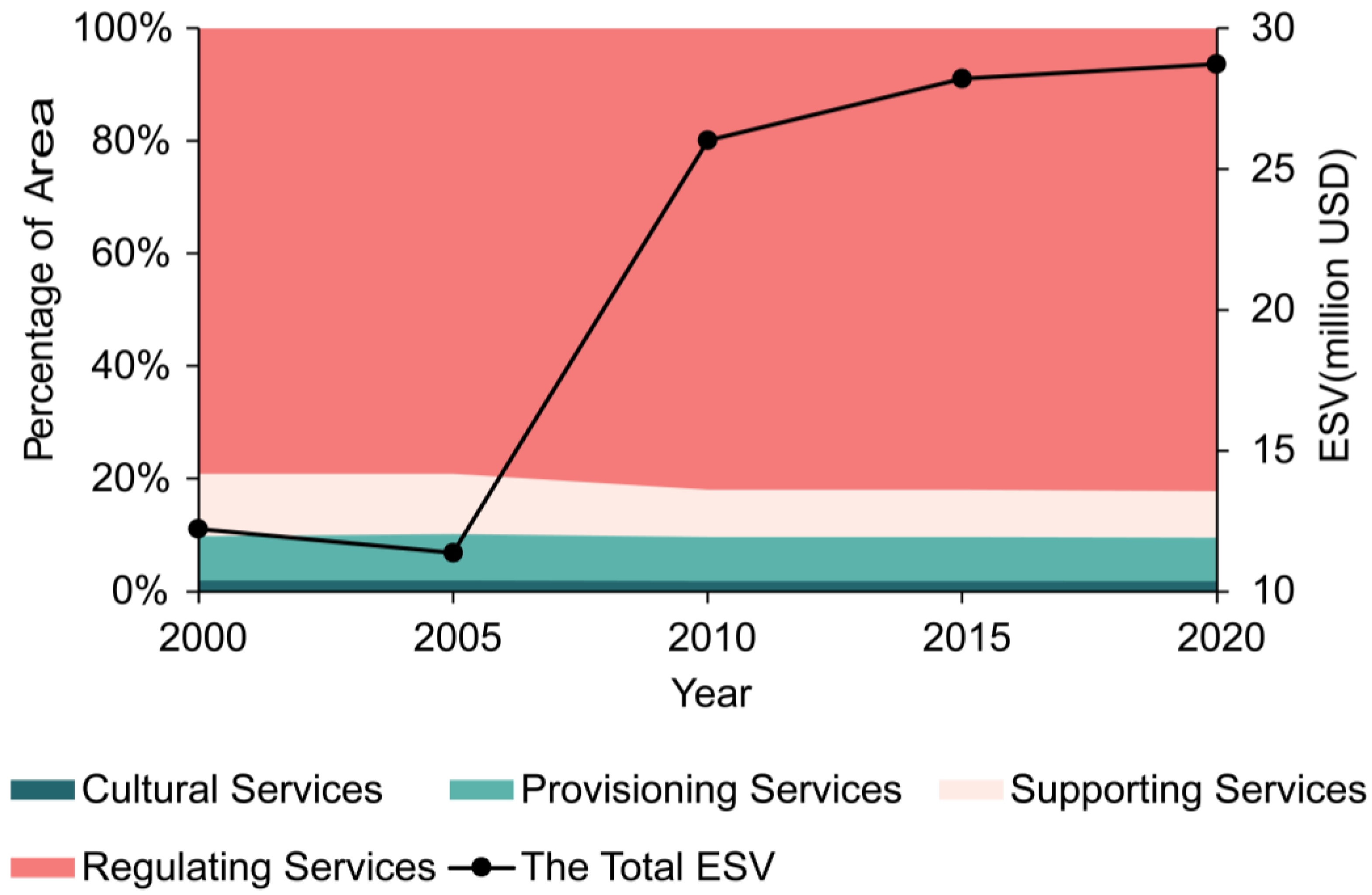
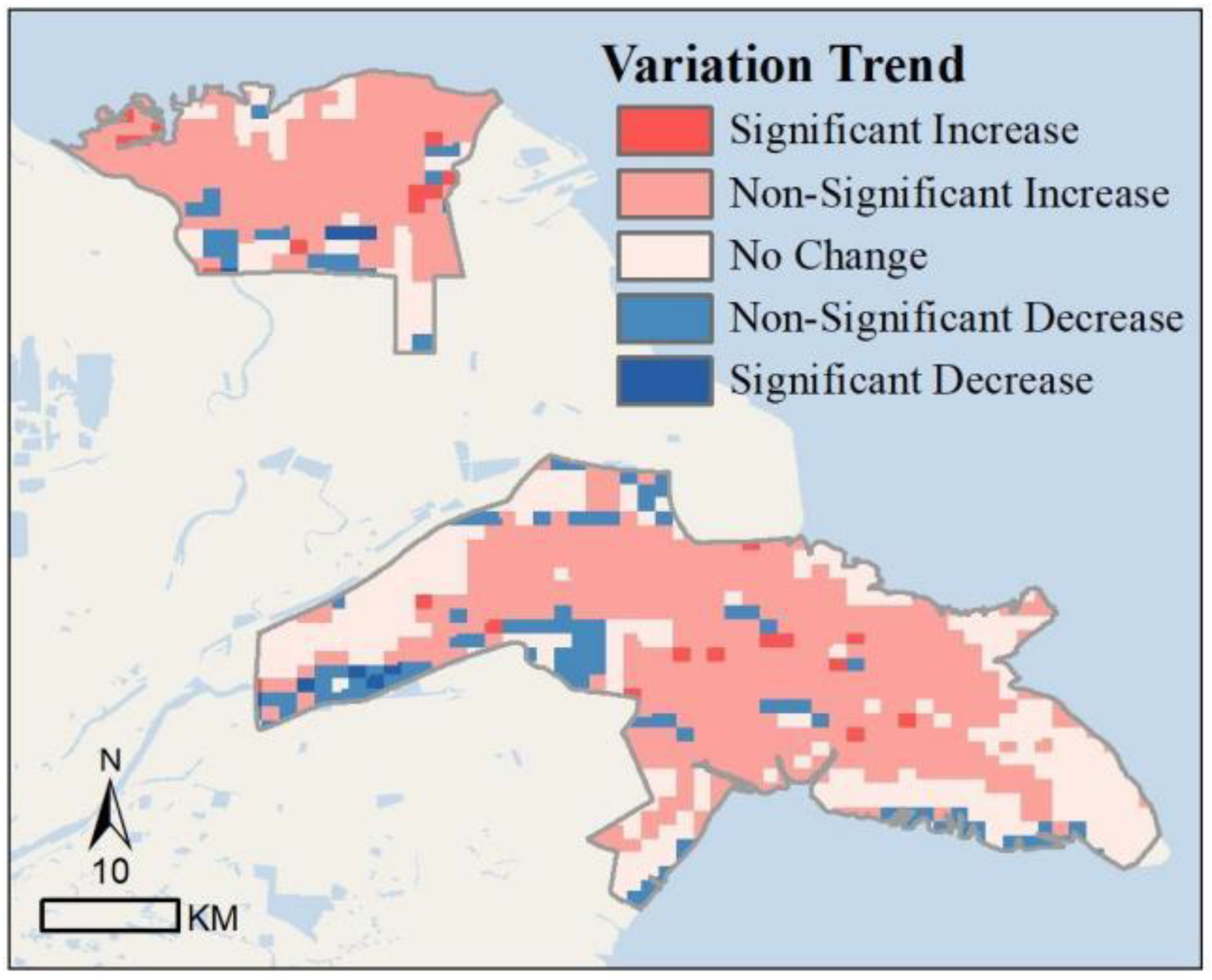

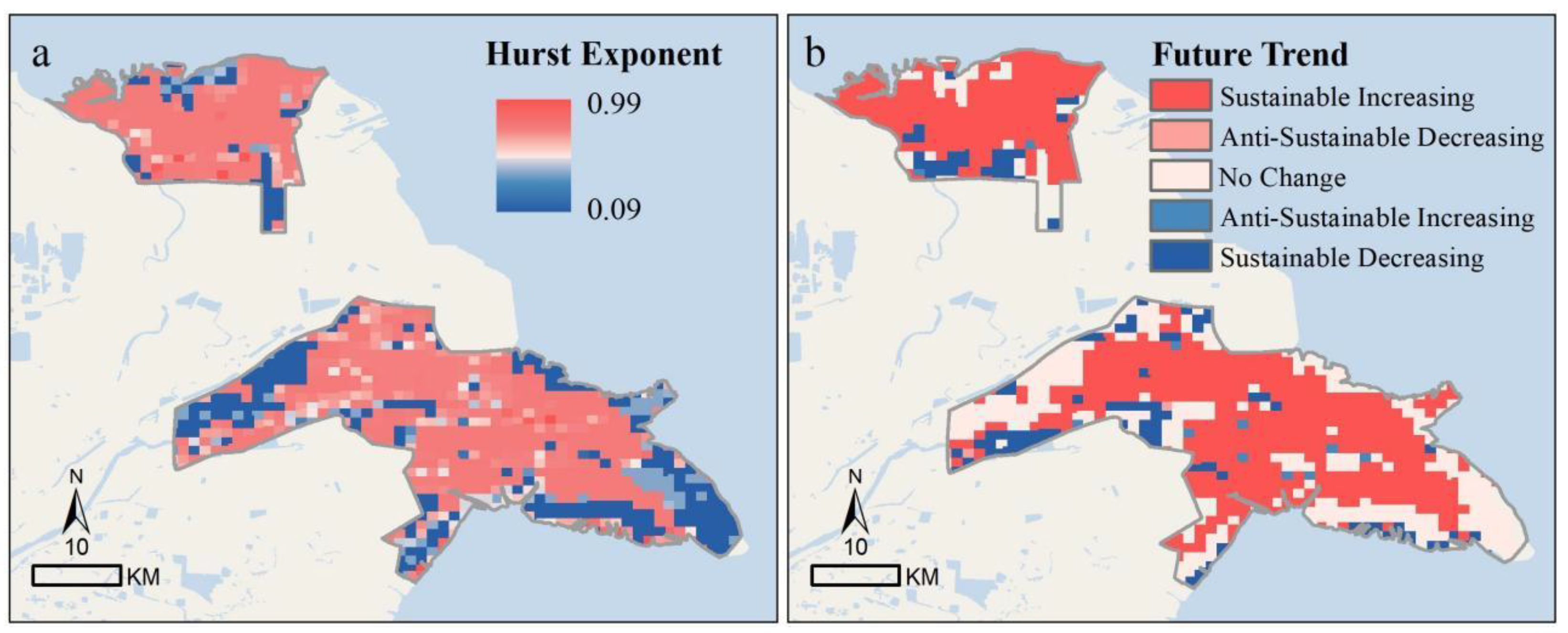
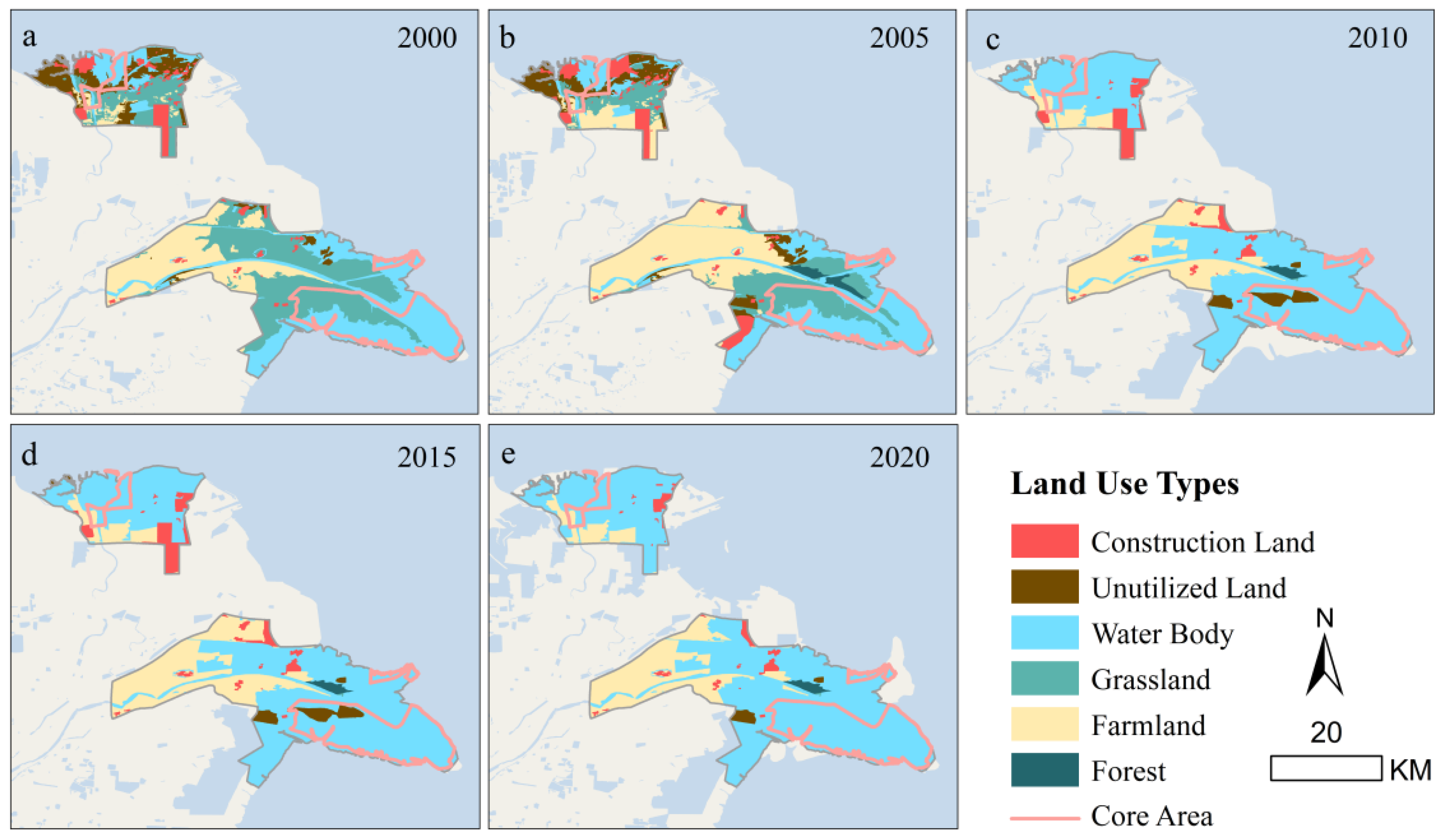
| Data Name | Data Sources | Spatial Resolution/m |
|---|---|---|
| Reserve boundary | https://www.resdc.cn/ URL (accessed on 12 October 2024) | - |
| Land use | https://www.resdc.cn/ URL (accessed on 13 October 2024) | 30 |
| Sown area and yield of food crops | Shandong Statistical Yearbook | - |
| Grain price | National Agricultural Product Cost and Benefit Data Compilation | - |
| NDVI | https://www.resdc.cn/ URL (accessed on 15 October 2024) | 1000 |
| DEM | https://www.gebco.net/ URL (accessed on 19 October 2024) | 12.5 |
| Precipitation | https://www.resdc.cn/ URL (accessed on 27 October 2024) | 1000 |
| Population | https://hub.worldpop.org/ URL (accessed on 27 October 2024) | 1000 |
| GDP | https://www.resdc.cn/ URL (accessed on 23 October 2024) | 1000 |
| Road | https://download.geofabrik.de/ URL (accessed on 10 April 2025) | - |
| Ecosystem Classification | Unit area ESV Equivalents | ||||||
|---|---|---|---|---|---|---|---|
| Primary | Secondary | Farmland | Forest | Grassland | Water Body | Construction Land | Unutilized Land |
| Provisioning services | Food | 1.73 | 0.51 | 0.61 | 1.34 | 0.00 | 0.00 |
| Materials | 0.82 | 1.18 | 0.92 | 0.75 | 0.00 | 0.00 | |
| Water | 0.04 | 0.61 | 0.51 | 11.10 | 0.00 | 0.00 | |
| Regulating services | Gas | 1.37 | 3.88 | 3.18 | 2.73 | 0.00 | 0.04 |
| Climate | 0.73 | 11.63 | 8.40 | 6.01 | 0.00 | 0.00 | |
| Purification | 0.20 | 3.41 | 2.77 | 9.33 | 0.00 | 0.20 | |
| Hydrology | 0.55 | 7.63 | 6.16 | 129.00 | 0.00 | 0.06 | |
| Supporting services | Soil conservation | 2.10 | 4.73 | 3.88 | 3.31 | 0.00 | 0.04 |
| Maintaining nutrient cycling | 0.24 | 0.37 | 0.31 | 0.26 | 0.00 | 0.00 | |
| Biodiversity | 0.27 | 4.32 | 3.53 | 10.63 | 0.00 | 0.04 | |
| Cultural services | Esthetic landscape | 0.06 | 0.93 | 0.76 | 3.31 | 0.00 | 0.02 |
| Z | Trend of ESV | |
|---|---|---|
| Significant Increase | ||
| Non-Significant Increase | ||
| No Change | ||
| Non-Significant Decrease | ||
| Significant Decrease |
| LULC | Year | ||||
|---|---|---|---|---|---|
| 2000 | 2005 | 2010 | 2015 | 2020 | |
| Farmland | 0.02 | 0.04 | 0.02 | 0.02 | 0.01 |
| Forest | 0.00 | 0.01 | 0.00 | 0.00 | 0.00 |
| Grassland | 0.16 | 0.10 | 0.00 | 0.00 | 0.00 |
| Water body | 0.82 | 0.85 | 0.98 | 0.98 | 0.99 |
| Construction land | 0.00 | 0.00 | 0.00 | 0.00 | 0.00 |
| Unutilized land | 0.00 | 0.00 | 0.00 | 0.00 | 0.00 |
| LULC | Year | ||||
|---|---|---|---|---|---|
| 2000 | 2005 | 2010 | 2015 | 2020 | |
| Farmland | 27.290 | 44.310 | 41.616 | 45.158 | 34.775 |
| Forest | 0.000 | 11.380 | 6.661 | 7.242 | 6.536 |
| Grassland | 192.450 | 113.059 | 0.192 | 0.209 | 0.203 |
| Water body | 1000.217 | 967.118 | 2553.472 | 2768.524 | 2830.986 |
| Construction land | 0.000 | 0.000 | 0.000 | 0.000 | 0.000 |
| Unutilized land | 0.616 | 0.672 | 0.236 | 0.273 | 0.072 |
| Total | 1220.573 | 1136.539 | 2601.777 | 2821.426 | 2872.572 |
| Future Trend | Development Direction | Percentage of Area/% |
|---|---|---|
| Continuously increasing | Continuously increasing | 64.35 |
| Anti-Sustainable decreasing | Decreased in the past but increasing in the future | 0.26 |
| Anti-Sustainable increasing | Increased in the past but decreasing in the future | 1.18 |
| Continuously decreasing | Continuously decreasing | 10.36 |
| No change | Essentially unchanged | 23.85 |
| LULC | 2005 | |||||||
|---|---|---|---|---|---|---|---|---|
| Grassland | Farmland | Construction Land | Forest | Water Body | Unutilized Land | Total | ||
| 2000 | Grassland | 20,184.68 | 10,829.90 | 1324.66 | 1668.33 | 220.02 | 1897.64 | 36,125.23 |
| Farmland | 41.12 | 19,522.90 | 7.49 | 0.00 | 12.78 | 11.94 | 19,596.23 | |
| Construction land | 18.24 | 18.88 | 4781.58 | 0.00 | 9.29 | 24.21 | 4852.20 | |
| Water body | 742.45 | 80.05 | 860.32 | 4.03 | 31,055.24 | 46.28 | 32,788.38 | |
| Unutilized land | 9.98 | 1038.00 | 242.03 | 0.00 | 49.23 | 7689.37 | 9028.62 | |
| Total | 20,996.47 | 31,489.74 | 7216.08 | 1672.36 | 31,346.57 | 9669.44 | 102,390.65 | |
| LULC | 2015 | |||||||
|---|---|---|---|---|---|---|---|---|
| Grassland | Farmland | Construction Land | Forest | Water Body | Unutilized Land | Total | ||
| 2010 | Grassland | 29.72 | 0.00 | 0.00 | 0.00 | 0.35 | 0.00 | 30.07 |
| Farmland | 0.00 | 24,374.67 | 41.93 | 0.35 | 38.91 | 0.00 | 24,455.85 | |
| Construction land | 0.00 | 8.86 | 5892.36 | 0.00 | 9.07 | 0.00 | 5910.29 | |
| Forest | 0.46 | 0.00 | 0.00 | 805.73 | 2.88 | 0.00 | 809.07 | |
| Water body | 0.00 | 27.15 | 14.00 | 2.76 | 68,209.33 | 151.69 | 68,404.93 | |
| Unutilized land | 0.00 | 0.00 | 0.11 | 0.00 | 8.97 | 2771.35 | 2780.44 | |
| Total | 30.18 | 24,410.68 | 5948.40 | 808.84 | 68,269.51 | 2923.04 | 102,390.65 | |
Disclaimer/Publisher’s Note: The statements, opinions and data contained in all publications are solely those of the individual author(s) and contributor(s) and not of MDPI and/or the editor(s). MDPI and/or the editor(s) disclaim responsibility for any injury to people or property resulting from any ideas, methods, instructions or products referred to in the content. |
© 2025 by the authors. Licensee MDPI, Basel, Switzerland. This article is an open access article distributed under the terms and conditions of the Creative Commons Attribution (CC BY) license (https://creativecommons.org/licenses/by/4.0/).
Share and Cite
Shi, S.; Xu, S.; Meng, Z. Ecosystem Service Value Dynamics in the Yellow River Delta National Nature Reserve, China: Conservation Implications from Two Decades of Change. Sustainability 2025, 17, 9291. https://doi.org/10.3390/su17209291
Shi S, Xu S, Meng Z. Ecosystem Service Value Dynamics in the Yellow River Delta National Nature Reserve, China: Conservation Implications from Two Decades of Change. Sustainability. 2025; 17(20):9291. https://doi.org/10.3390/su17209291
Chicago/Turabian StyleShi, Shuxin, Shengyuan Xu, and Ziqi Meng. 2025. "Ecosystem Service Value Dynamics in the Yellow River Delta National Nature Reserve, China: Conservation Implications from Two Decades of Change" Sustainability 17, no. 20: 9291. https://doi.org/10.3390/su17209291
APA StyleShi, S., Xu, S., & Meng, Z. (2025). Ecosystem Service Value Dynamics in the Yellow River Delta National Nature Reserve, China: Conservation Implications from Two Decades of Change. Sustainability, 17(20), 9291. https://doi.org/10.3390/su17209291





